Michal Shmueli-Scheuer
Think Again! The Effect of Test-Time Compute on Preferences, Opinions, and Beliefs of Large Language Models
May 26, 2025Abstract:As Large Language Models (LLMs) become deeply integrated into human life and increasingly influence decision-making, it's crucial to evaluate whether and to what extent they exhibit subjective preferences, opinions, and beliefs. These tendencies may stem from biases within the models, which may shape their behavior, influence the advice and recommendations they offer to users, and potentially reinforce certain viewpoints. This paper presents the Preference, Opinion, and Belief survey (POBs), a benchmark developed to assess LLMs' subjective inclinations across societal, cultural, ethical, and personal domains. We applied our benchmark to evaluate leading open- and closed-source LLMs, measuring desired properties such as reliability, neutrality, and consistency. In addition, we investigated the effect of increasing the test-time compute, through reasoning and self-reflection mechanisms, on those metrics. While effective in other tasks, our results show that these mechanisms offer only limited gains in our domain. Furthermore, we reveal that newer model versions are becoming less consistent and more biased toward specific viewpoints, highlighting a blind spot and a concerning trend. POBS: https://ibm.github.io/POBS
Survey on Evaluation of LLM-based Agents
Mar 20, 2025Abstract:The emergence of LLM-based agents represents a paradigm shift in AI, enabling autonomous systems to plan, reason, use tools, and maintain memory while interacting with dynamic environments. This paper provides the first comprehensive survey of evaluation methodologies for these increasingly capable agents. We systematically analyze evaluation benchmarks and frameworks across four critical dimensions: (1) fundamental agent capabilities, including planning, tool use, self-reflection, and memory; (2) application-specific benchmarks for web, software engineering, scientific, and conversational agents; (3) benchmarks for generalist agents; and (4) frameworks for evaluating agents. Our analysis reveals emerging trends, including a shift toward more realistic, challenging evaluations with continuously updated benchmarks. We also identify critical gaps that future research must address-particularly in assessing cost-efficiency, safety, and robustness, and in developing fine-grained, and scalable evaluation methods. This survey maps the rapidly evolving landscape of agent evaluation, reveals the emerging trends in the field, identifies current limitations, and proposes directions for future research.
DOVE: A Large-Scale Multi-Dimensional Predictions Dataset Towards Meaningful LLM Evaluation
Mar 04, 2025Abstract:Recent work found that LLMs are sensitive to a wide range of arbitrary prompt dimensions, including the type of delimiters, answer enumerators, instruction wording, and more. This throws into question popular single-prompt evaluation practices. We present DOVE (Dataset Of Variation Evaluation) a large-scale dataset containing prompt perturbations of various evaluation benchmarks. In contrast to previous work, we examine LLM sensitivity from an holistic perspective, and assess the joint effects of perturbations along various dimensions, resulting in thousands of perturbations per instance. We evaluate several model families against DOVE, leading to several findings, including efficient methods for choosing well-performing prompts, observing that few-shot examples reduce sensitivity, and identifying instances which are inherently hard across all perturbations. DOVE consists of more than 250M prompt perturbations and model outputs, which we make publicly available to spur a community-wide effort toward meaningful, robust, and efficient evaluation. Browse the data, contribute, and more: https://slab-nlp.github.io/DOVE/
The Mighty ToRR: A Benchmark for Table Reasoning and Robustness
Feb 26, 2025



Abstract:Despite its real-world significance, model performance on tabular data remains underexplored, leaving uncertainty about which model to rely on and which prompt configuration to adopt. To address this gap, we create ToRR, a benchmark for Table Reasoning and Robustness, that measures model performance and robustness on table-related tasks. The benchmark includes 10 datasets that cover different types of table reasoning capabilities across varied domains. ToRR goes beyond model performance rankings, and is designed to reflect whether models can handle tabular data consistently and robustly, across a variety of common table representation formats. We present a leaderboard as well as comprehensive analyses of the results of leading models over ToRR. Our results reveal a striking pattern of brittle model behavior, where even strong models are unable to perform robustly on tabular data tasks. Although no specific table format leads to consistently better performance, we show that testing over multiple formats is crucial for reliably estimating model capabilities. Moreover, we show that the reliability boost from testing multiple prompts can be equivalent to adding more test examples. Overall, our findings show that table understanding and reasoning tasks remain a significant challenge.
Stay Tuned: An Empirical Study of the Impact of Hyperparameters on LLM Tuning in Real-World Applications
Jul 25, 2024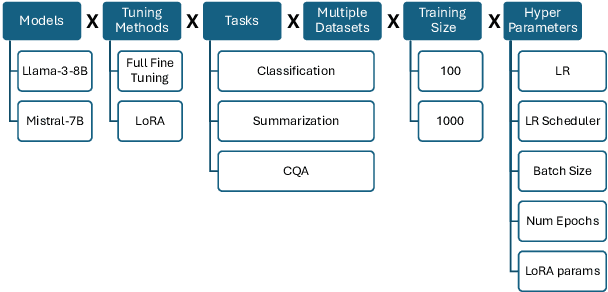


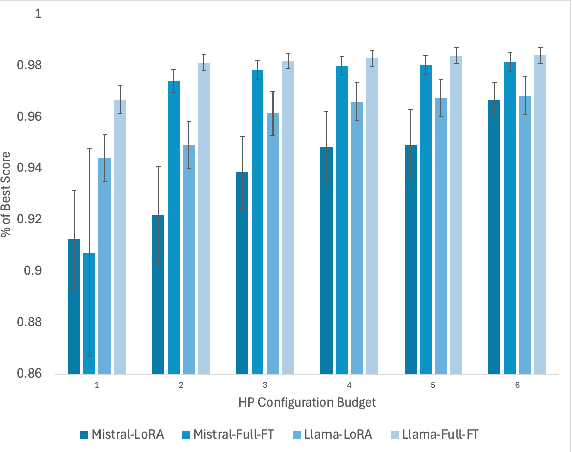
Abstract:Fine-tuning Large Language Models (LLMs) is an effective method to enhance their performance on downstream tasks. However, choosing the appropriate setting of tuning hyperparameters (HPs) is a labor-intensive and computationally expensive process. Here, we provide recommended HP configurations for practical use-cases that represent a better starting point for practitioners, when considering two SOTA LLMs and two commonly used tuning methods. We describe Coverage-based Search (CBS), a process for ranking HP configurations based on an offline extensive grid search, such that the top ranked configurations collectively provide a practical robust recommendation for a wide range of datasets and domains. We focus our experiments on Llama-3-8B and Mistral-7B, as well as full fine-tuning and LoRa, conducting a total of > 10,000 tuning experiments. Our results suggest that, in general, Llama-3-8B and LoRA should be preferred, when possible. Moreover, we show that for both models and tuning methods, exploring only a few HP configurations, as recommended by our analysis, can provide excellent results in practice, making this work a valuable resource for practitioners.
Benchmark Agreement Testing Done Right: A Guide for LLM Benchmark Evaluation
Jul 18, 2024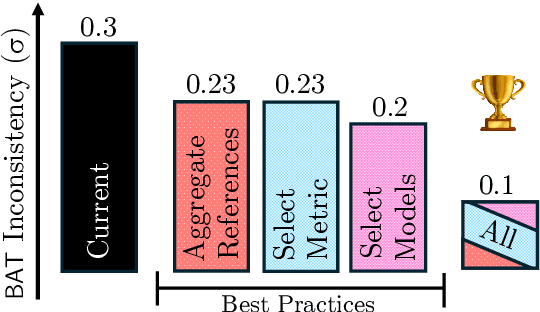
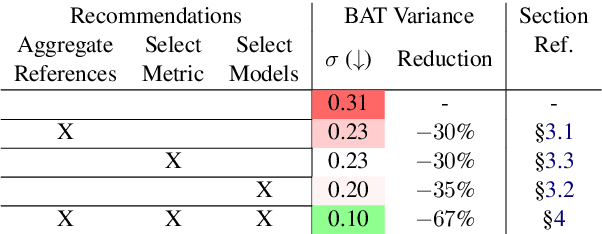
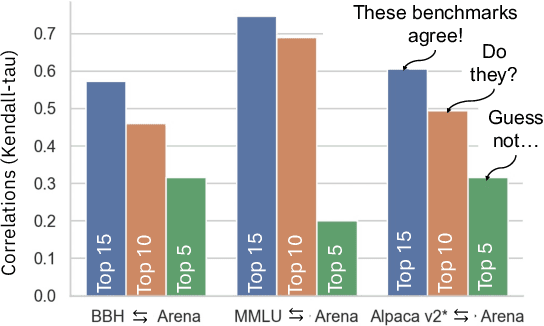
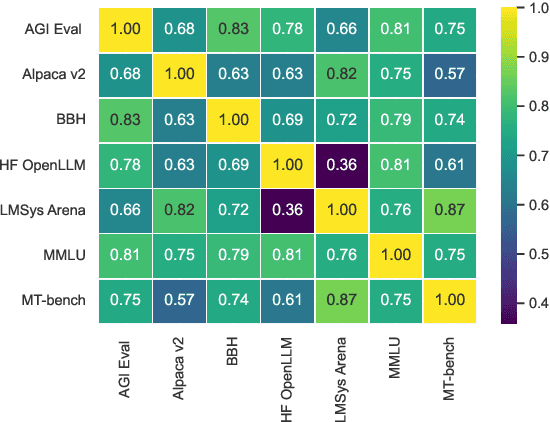
Abstract:Recent advancements in Language Models (LMs) have catalyzed the creation of multiple benchmarks, designed to assess these models' general capabilities. A crucial task, however, is assessing the validity of the benchmarks themselves. This is most commonly done via Benchmark Agreement Testing (BAT), where new benchmarks are validated against established ones using some agreement metric (e.g., rank correlation). Despite the crucial role of BAT for benchmark builders and consumers, there are no standardized procedures for such agreement testing. This deficiency can lead to invalid conclusions, fostering mistrust in benchmarks and upending the ability to properly choose the appropriate benchmark to use. By analyzing over 40 prominent benchmarks, we demonstrate how some overlooked methodological choices can significantly influence BAT results, potentially undermining the validity of conclusions. To address these inconsistencies, we propose a set of best practices for BAT and demonstrate how utilizing these methodologies greatly improves BAT robustness and validity. To foster adoption and facilitate future research,, we introduce BenchBench, a python package for BAT, and release the BenchBench-leaderboard, a meta-benchmark designed to evaluate benchmarks using their peers. Our findings underscore the necessity for standardized BAT, ensuring the robustness and validity of benchmark evaluations in the evolving landscape of language model research. BenchBench Package: https://github.com/IBM/BenchBench Leaderboard: https://huggingface.co/spaces/per/BenchBench
Unitxt: Flexible, Shareable and Reusable Data Preparation and Evaluation for Generative AI
Jan 25, 2024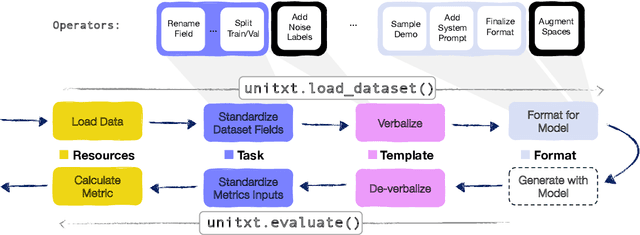
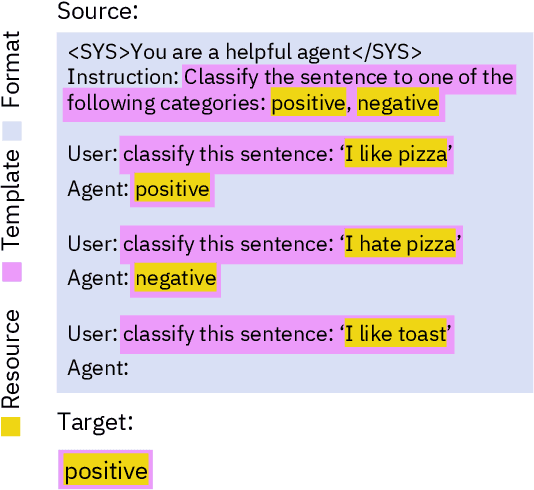
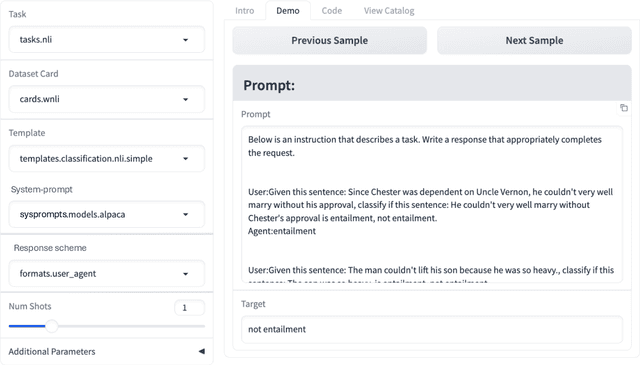
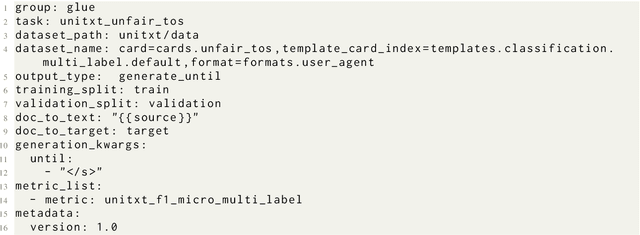
Abstract:In the dynamic landscape of generative NLP, traditional text processing pipelines limit research flexibility and reproducibility, as they are tailored to specific dataset, task, and model combinations. The escalating complexity, involving system prompts, model-specific formats, instructions, and more, calls for a shift to a structured, modular, and customizable solution. Addressing this need, we present Unitxt, an innovative library for customizable textual data preparation and evaluation tailored to generative language models. Unitxt natively integrates with common libraries like HuggingFace and LM-eval-harness and deconstructs processing flows into modular components, enabling easy customization and sharing between practitioners. These components encompass model-specific formats, task prompts, and many other comprehensive dataset processing definitions. The Unitxt-Catalog centralizes these components, fostering collaboration and exploration in modern textual data workflows. Beyond being a tool, Unitxt is a community-driven platform, empowering users to build, share, and advance their pipelines collaboratively. Join the Unitxt community at https://github.com/IBM/unitxt!
Efficient Benchmarking (of Language Models)
Aug 31, 2023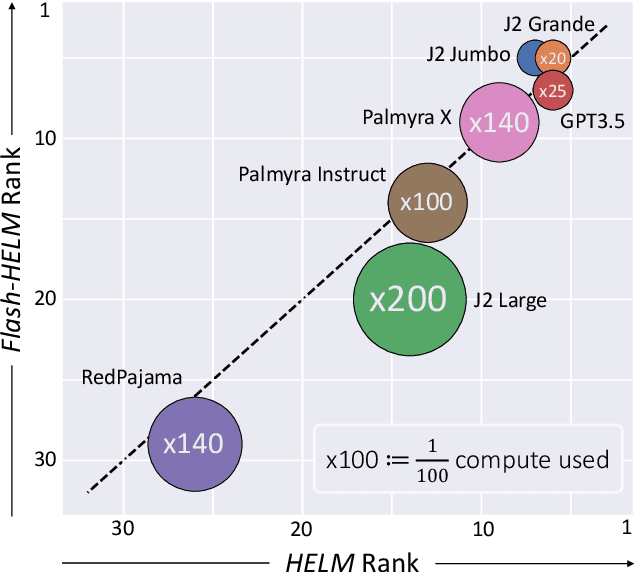
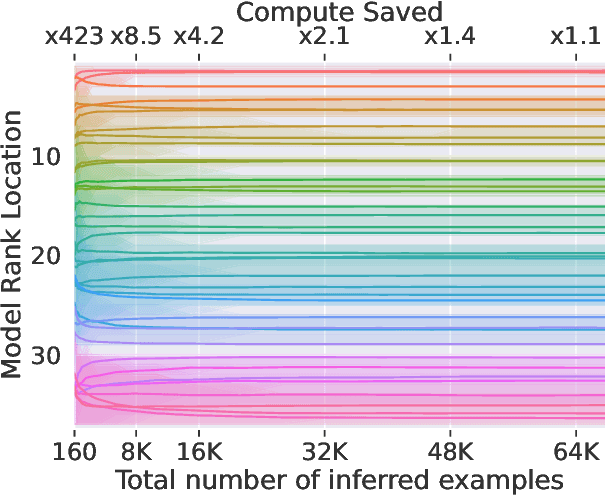
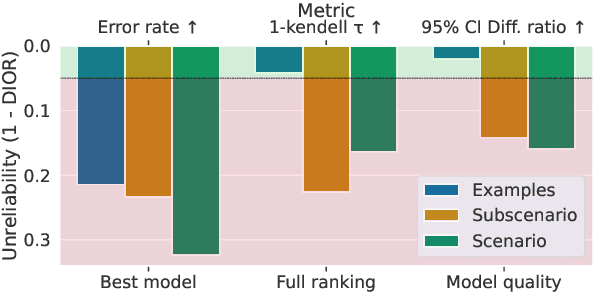
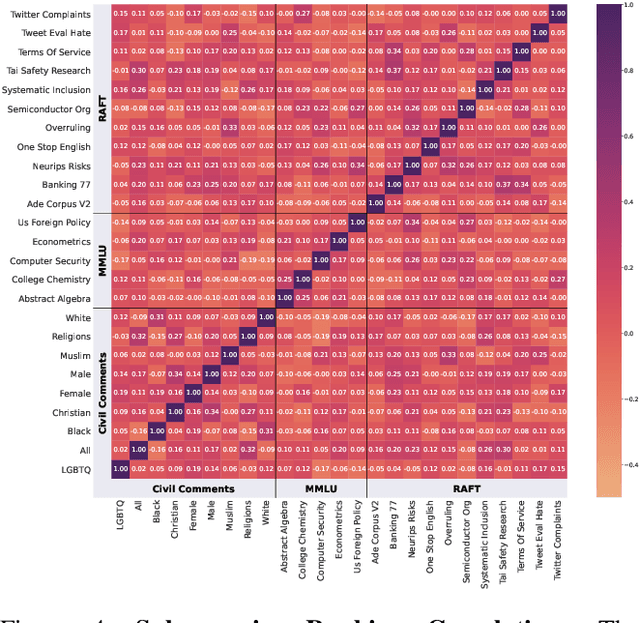
Abstract:The increasing versatility of language models LMs has given rise to a new class of benchmarks that comprehensively assess a broad range of capabilities. Such benchmarks are associated with massive computational costs reaching thousands of GPU hours per model. However the efficiency aspect of these evaluation efforts had raised little discussion in the literature. In this work we present the problem of Efficient Benchmarking namely intelligently reducing the computation costs of LM evaluation without compromising reliability. Using the HELM benchmark as a test case we investigate how different benchmark design choices affect the computation-reliability tradeoff. We propose to evaluate the reliability of such decisions by using a new measure Decision Impact on Reliability DIoR for short. We find for example that the current leader on HELM may change by merely removing a low-ranked model from the benchmark and observe that a handful of examples suffice to obtain the correct benchmark ranking. Conversely a slightly different choice of HELM scenarios varies ranking widely. Based on our findings we outline a set of concrete recommendations for more efficient benchmark design and utilization practices leading to dramatic cost savings with minimal loss of benchmark reliability often reducing computation by x100 or more.
Active Learning for Natural Language Generation
May 24, 2023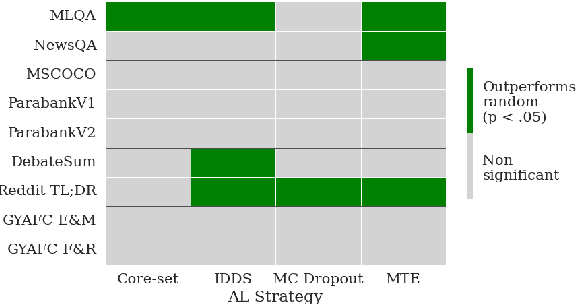

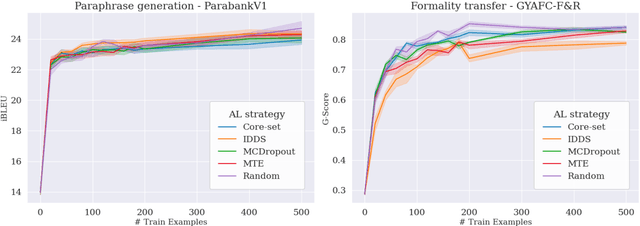
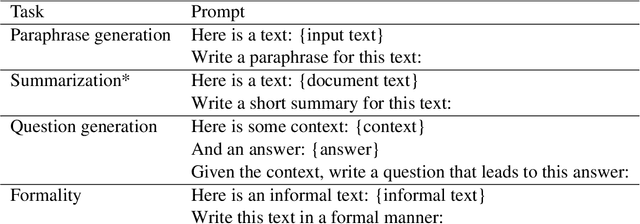
Abstract:The field of text generation suffers from a severe shortage of labeled data due to the extremely expensive and time consuming process involved in manual annotation. A natural approach for coping with this problem is active learning (AL), a well-known machine learning technique for improving annotation efficiency by selectively choosing the most informative examples to label. However, while AL has been well-researched in the context of text classification, its application to text generation remained largely unexplored. In this paper, we present a first systematic study of active learning for text generation, considering a diverse set of tasks and multiple leading AL strategies. Our results indicate that existing AL strategies, despite their success in classification, are largely ineffective for the text generation scenario, and fail to consistently surpass the baseline of random example selection. We highlight some notable differences between the classification and generation scenarios, and analyze the selection behaviors of existing AL strategies. Our findings motivate exploring novel approaches for applying AL to NLG tasks.
nBIIG: A Neural BI Insights Generation System for Table Reporting
Nov 08, 2022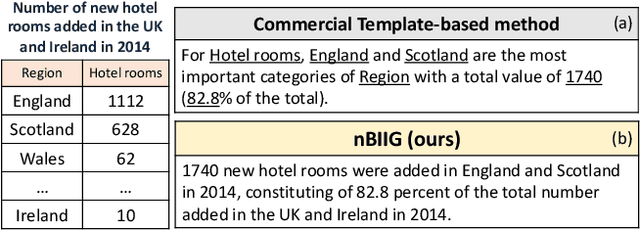

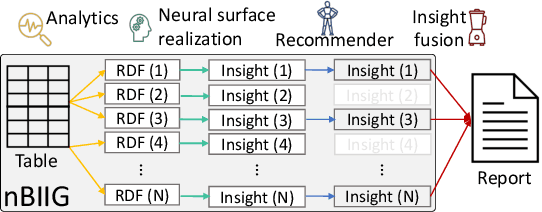
Abstract:We present nBIIG, a neural Business Intelligence (BI) Insights Generation system. Given a table, our system applies various analyses to create corresponding RDF representations, and then uses a neural model to generate fluent textual insights out of these representations. The generated insights can be used by an analyst, via a human-in-the-loop paradigm, to enhance the task of creating compelling table reports. The underlying generative neural model is trained over large and carefully distilled data, curated from multiple BI domains. Thus, the system can generate faithful and fluent insights over open-domain tables, making it practical and useful.
 Add to Chrome
Add to Chrome Add to Firefox
Add to Firefox Add to Edge
Add to Edge